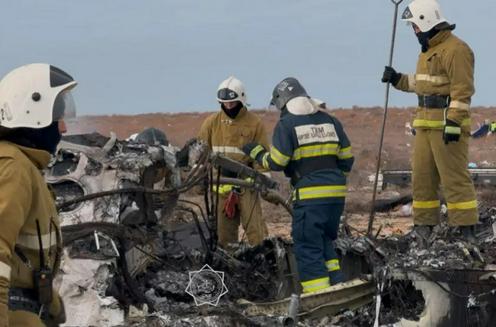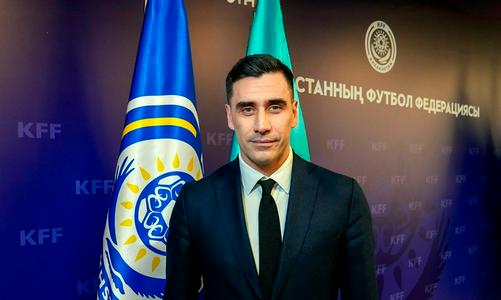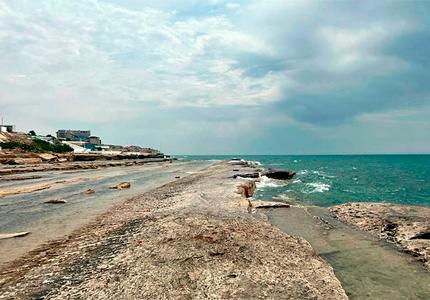Investigators have discovered numerous holes and foreign metal objects in the fuselage of the Azerbaijan Airlines (AZAL) aircraft that crashed near Aktau Airport. These findings were detailed in a preliminary report on the crash investigation published by Kazakhstan’s Ministry of Transport.
“An initial inspection of the remaining fragments revealed multiple perforations and non-perforating damage of various sizes and shapes in the aircraft’s tail section, vertical stabilizer, horizontal stabilizer, elevators, and rudder. Similar damage was found on the left engine and left wing, as well as on various aircraft components and systems. In some areas, the damage had a distinct rectangular shape,” the document states.
According to the experts’ findings, external objects penetrated parts of the aircraft, damaging its hydraulic systems before impact with the ground. These damages led to a loss of hydraulic fluid and pressure.
-

Photo from the preliminary report by the Ministry of Transport of Kazakhstan
-

Photo from the preliminary report by the Ministry of Transport of Kazakhstan
-

Photo from the preliminary report by the Ministry of Transport of Kazakhstan
-

Photo from the preliminary report by the Ministry of Transport of Kazakhstan
-
Photo from the preliminary report by the Ministry of Transport of Kazakhstan
-

Photo from the preliminary report by the Ministry of Transport of Kazakhstan
Most of the perforations were found in the vertical and horizontal stabilizers. Several foreign metal objects were retrieved from the No. 3 hydraulic system compartment, the left stabilizer, and the auxiliary power unit (APU) bay. “Further analysis and examinations will be conducted to determine the nature and origin of the perforations caused by these foreign objects,” the report states.
The document provides a detailed account of the aircraft’s flight and the crew’s attempts to land in Grozny. According to the published data, two “loud bangs” were recorded approximately 20 seconds apart during the approach. The crew initially identified these as a “bird strike on the cockpit” and an “explosion of two seats on board.” Shortly afterward, the autopilot disengaged, hydraulic pressure dropped, the trim system failed, and cabin depressurization began.
Investigators also noted that during the landing attempt, the aircraft’s GPS 1 and GPS 2 navigation systems were unable to receive satellite signals, while the distance measuring equipment (DME) failed to pick up signals from ground stations.
The report includes transcripts of communications between AZAL pilots and air traffic controllers in Grozny, Rostov-on-Don, and Aktau (previously published by the Telegram channel BAZA). The transcripts indicate that Russian controllers suggested several emergency landing options within Russian territory, but the pilots initially decided to return to Baku. As the flight progressed and system failures worsened, they changed course multiple times before ultimately heading to Aktau.
The document also contains a fragment of internal communication between Russian air traffic controllers regarding the activation of the “Kover” protocol (a procedure triggered in response to drone attacks), though the exact timing is not specified. This appears to have occurred after the aircraft sustained damage and altered its course. Previously, Azerbaijani President Ilham Aliyev stated that had the airspace over Grozny been closed in time, the crash could have been prevented.
According to preliminary data, the aircraft crashed seven minutes after being detected near Aktau Airport. It erratically changed its flight trajectory before breaking apart upon impact with the ground. Firefighters and rescue teams arrived at the crash site within seven minutes, where they found the aircraft’s rear section with civilians evacuating passengers. The forward section was burning approximately 300-350 meters away. The fire was fully extinguished another seven minutes later.
The crash occurred on December 25. The Embraer 190 operated by Azerbaijan Airlines was on a scheduled flight from Baku to Grozny but reportedly failed to land in the Chechen capital. The aircraft turned around and headed toward Aktau, Kazakhstan, while sending out a distress signal. It ultimately crashed three kilometers from the airport. Of the 67 people on board, 38 lost their lives, including citizens of Azerbaijan, Kazakhstan, and Russia.
Following the crash, various theories emerged, ranging from a bird strike to external interference with the aircraft. In late December, Azerbaijani President Ilham Aliyev accused Moscow of attempting to suppress information about the causes of the crash. He asserted that the aircraft had been disabled by electronic warfare measures and suffered significant damage to its tail section due to ground fire in Grozny, where Russian forces were reportedly repelling a Ukrainian drone attack at the time.
The Embraer’s black boxes were sent to Brazil, the aircraft’s country of manufacture, for analysis. By January 7, their data had been fully decoded.

















